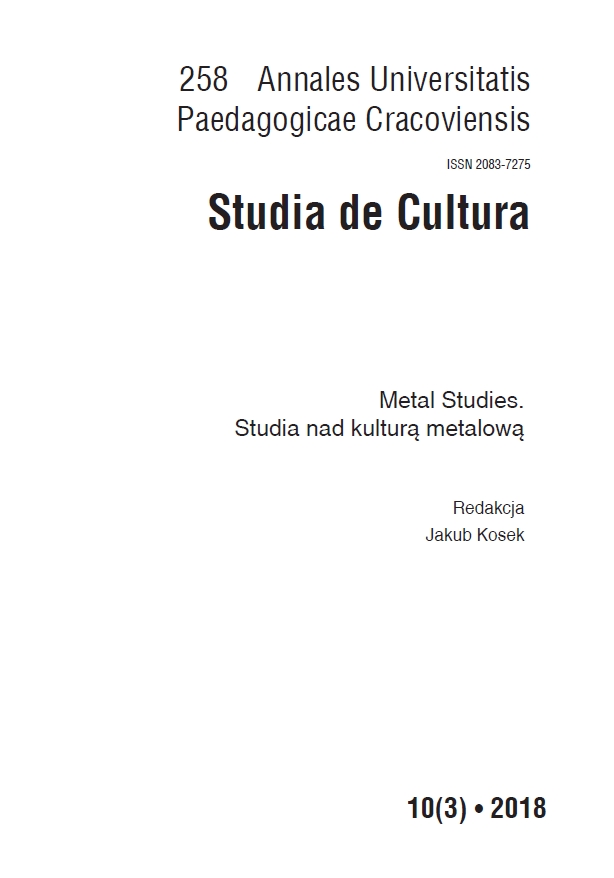Abstrakt
DOI 10.24917/20837275.10.3.12
Djent jest najmłodszym podgatunkiem metalu progresywnego, zarazem beneficjentem cyfrowej rewolucji. Przekracza tradycyjne modele muzyki popularnej i stara się ze wszech miar być nowatorski, ale jego awangardowość nie stanowi zaprzeczenia metalu, lecz znacząco wzbogaca zasób jego muzycznych środków. W djencie można jednocześnie widzieć symptomy (neo-)modernistyczne, czyli zachowanie indywidualizmu i autonomii, przy jednoczesnym zniesieniu granic i wdrażaniu utopijnego planu złączenia sztuki z życiem i społeczeństwem, niezrealizowanego w pełni przez pierwsze, historyczne awangardy.
Djent - digital metal neomoderne?
Deep-rooted ideas of “art rock” do not expire and recently gave rise to the new, progressive metal trends like djent. It wants to be the elite, the modern, and the innovative. At the expense of greater commercial success, djent bands cut off from the mainstream and operate independently, incessantly exceeding stylistic and aesthetical boundaries. Poetics of their music often reveal a tension between elitism and egalitarianism, intellect and corporeality, individuality and convention. But can it be seen as some kind of musical trans-avant-garde or neomodernistic?
Bibliografia
Adamowicz Klaudia. 2013. „Od subkultury do postsubkultury. Zmiany w obszarze dzisiejszej kultury alternatywnej”. Estetyka i Krytyka nr 29. 15–25.
Zobacz w Google Scholar
[B.a.] 2012. Guide to Djent Tone. Connorgilks.com. https://pl.scribd.com/document/252066409/Guide-to-Djent-Tone [dostęp: 12.09.2017].
Zobacz w Google Scholar
Bauman Zygmunt. 2006. Płynna nowoczesność. Kraków.
Zobacz w Google Scholar
Bonito Oliva Achille. 1982. Transavantgarde International. Milan.
Zobacz w Google Scholar
Bürger Peter. 1991. Aporias of Modern Aesthetics. W Thinking Art: Beyond Traditional Aesthetics. A. Benjamin, P. Osborne (red.). London.
Zobacz w Google Scholar
Bürger Peter. 2006. Teoria awangardy. J. Kita-Huber (przeł.). Kraków.
Zobacz w Google Scholar
Capuzzo Guy. 2014. A Cyclic Approach to Rhythm and Meter in the Music of Meshuggah. American Musicological Society / Society for Music Theory Joint Meeting 2014. Milwaukee.
Zobacz w Google Scholar
Covach John. 1997. Progressive Rock, “Close to the Edge,” and the Boundaries of Style. W Understanding Rock: Essays in Musical Analysis, G.M. Boone, J. Covach (red.). New York. 3–31.
Zobacz w Google Scholar
Dziamski Grzegorz. 2002. „Spoglądając na sztukę minionego wieku”. Estetyka i krytyka nr 2. 25–39.
Zobacz w Google Scholar
Foege Alec. 1994. Confusion Is Next: The Sonic Youth Story. New York.
Zobacz w Google Scholar
Gracyk Theodore. 1992. “Adorno, Jazz, and the Aesthetics of Popular Music”. Musical Quarterly 76 no. 4. 526–542.
Zobacz w Google Scholar
Gracyk Theodore. 2008. The Aesthetics of Popular Music. (hasło) W The Internet Encyclopedia of Philosophy. http://www.iep.utm.edu/m/music-po.htm [dostęp: 12.09.2017].
Zobacz w Google Scholar
Greenberg Clement. 2006. Antyawangarda. W Obrona modernizmu. Wybór esejów. G. Dziamski, M. Śpik-Dziamska (przeł.). Kraków.
Zobacz w Google Scholar
Hallaråker Petter. 2013. Rytmisk metal: En studie av polyrytmikk og polymetrikk, med utgangspunkt Ibandet Meshuggah. Thesis, University of Agder.
Zobacz w Google Scholar
Hjelm Titus, Kahn-Harris Keith, LeVine Mark. 2011. Heavy metal as controversy and counterculture Popular Music History Vol 6. 5–18.
Zobacz w Google Scholar
Holm-Hudson Kevin. (red). 2002. Progressive Rock Reconsidered. New York–London.
Zobacz w Google Scholar
Kahn-Harris Keith. 2007. Extreme Metal: Music and Culture on the Edge. Oxford.
Zobacz w Google Scholar
Kania Andrew. 2006. “Making Tracks: The Ontology of Rock Music”. The Journal of Aesthetics and Art Criticism nr 64(4). 401–414.
Zobacz w Google Scholar
Kramer Jonathan. 1996. “Postmodern Concepts of Musical Time”. Indiana Theory Review Vol. 17/2. 21–61
Zobacz w Google Scholar
Kramer Jonathan. 1999. “The Nature and Origins of Musical Postmodernism”. Current Musicology no. 66. 7–20.
Zobacz w Google Scholar
Krauss Rosalind E. 2012. Oryginalność awangardy i inne mity modernistyczne. M. Szuba (przeł.). Gdańsk.
Zobacz w Google Scholar
Martin Bill. 2002. Avant Rock: Experimental Music from the Beatles to Björk, T. 35. Chicago.
Zobacz w Google Scholar
Martin Bill. 1998. Listening to the Future: The Time of Progressive Rock, 1968–1978. Chicago.
Zobacz w Google Scholar
Makimoto Tsugio, Manners David. 1997. Digital Nomad. New York.
Zobacz w Google Scholar
Morawski Stefan. 1975. „Awangardy XX wieku: stara i nowa”. Miesięcznik Literacki nr 3. 3–23.
Zobacz w Google Scholar
Morawski Stefan. 1985. Awangarda artystyczna (o dwu formacjach XX wieku). W tenże, Na zakręcie: od sztuki do po-sztuki. Kraków.
Zobacz w Google Scholar
Morawski Stefan. 1995. Modernizm a postmodernizm – przedłużenie czy alternatywa. W Trudna ponowoczesność. Rozmowy z Z. Baumanem. A. Zeidler-Janiszewska (red.). Poznań. 137–146.
Zobacz w Google Scholar
Morawski Stefan. 2007. Awangarda artystyczna (o dwu formacjach XX wieku). W Wybór pism estetycznych. P.J. Przybysz, A. Zeidler-Janiszewska (wyb. i opr.). Kraków
Zobacz w Google Scholar
Nieto Oriol. 2013. Rhythmic and Metric Explorations of a Complex Metal Piece: Meshuggah’s Catch 33. New York.
Zobacz w Google Scholar
Osborn Brad. (2010) Beyond Verse and Chorus: Experimental Formal Structures in Post-Millennial Experimental Rock Music, PhD dissertation. Washington.
Zobacz w Google Scholar
Osborn Brad. 2011. “Understanding Through-Composition in Post-Rock, Math-Metal, and other Post-Millennial Rock Genres”. Journal of the Society for Music Theory Vol 17, nr 3. 213–233.
Zobacz w Google Scholar
Pieslak Jonathan. 2007. “Re-casting Metal: Rhythm and Meter in the Music of Meshuggah”. Music Theory Spectrum nr 29/2. 219–245.
Zobacz w Google Scholar
Prensky Marc. 2001. “Digital Natives, Digital Immigrants”. On the Horizon. MCB University Press Vol. 9 No. 5.
Zobacz w Google Scholar
Smialek Eric T. 2008. Rethinking Metal Aesthetics: Complexity, Authenticity, and Audience in Meshuggah’s I and Catch 33. Montréal.
Zobacz w Google Scholar
Strinati Dominic. 1995. An Introduction to Theories of Popular Culture. New York–London.
Zobacz w Google Scholar
Shelvock Matt. 2013. “The Progressive Heavy Metal Guitarist’s Signal Chain: Contemporary Analogue and Digital Strategies”. KES Transactions on Innovation in Music Vol 1 No 1, Special Edition – Innovation in Music. 126–138.
Zobacz w Google Scholar
Szwajgier Krzysztof. 2017. Transawangarda, Książka programowa Międzynarodowego Festiwalu Muzyki Współczesnej „Warszawska Jesień 2017”. 24–29.
Zobacz w Google Scholar
Tagg Philip. 1982. “Analysing popular music: theory, method and practice”. Popular Music nr 2. 37–67.
Zobacz w Google Scholar
Thomson Jamie. 2011. “Djent, the metal geeks microgenre”. The Guardian. https://www.theguardian.com/music/2011/mar/03/djent-metal-geeks [dostęp: 12.09.2017].
Zobacz w Google Scholar
Weinstein D. 1991. Heavy Metal: A Cultural Sociology. Lexington Books. Toronto–New York.
Zobacz w Google Scholar
Zeidler-Janiszewska Anna. 2006. O dawnych i dzisiejszych interpretacjach neoawangardy. W Wiek awangardy. L Bieszczad (red.). Kraków.
Zobacz w Google Scholar

